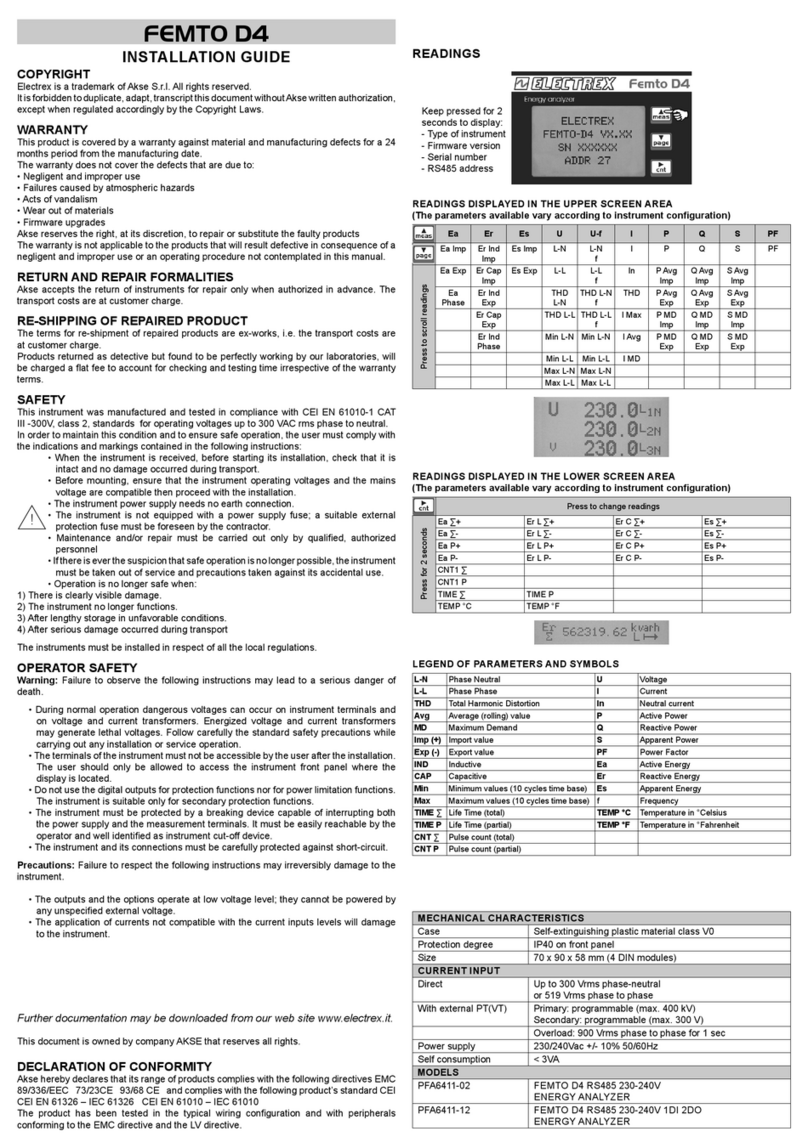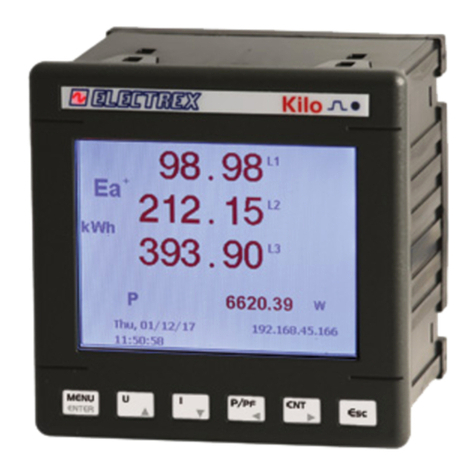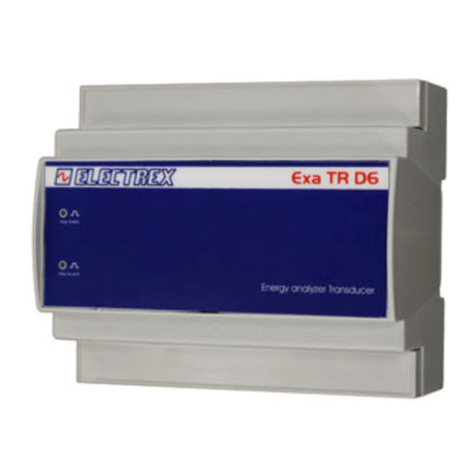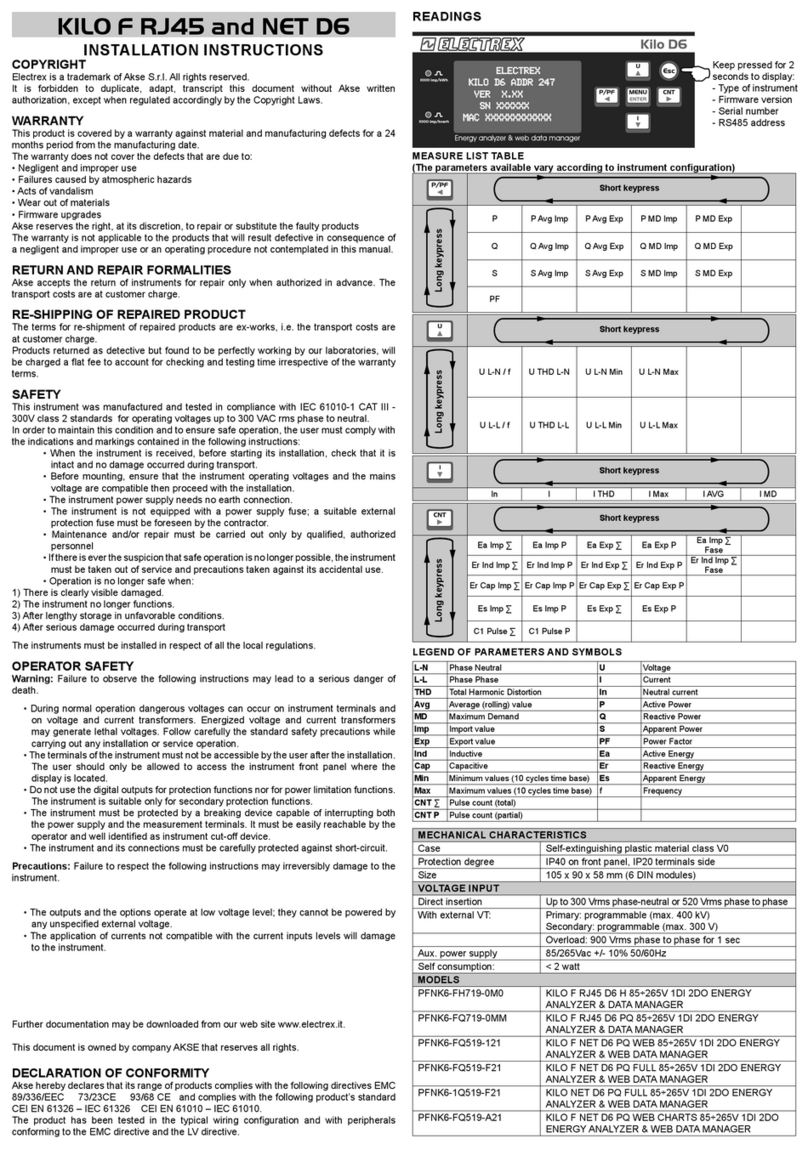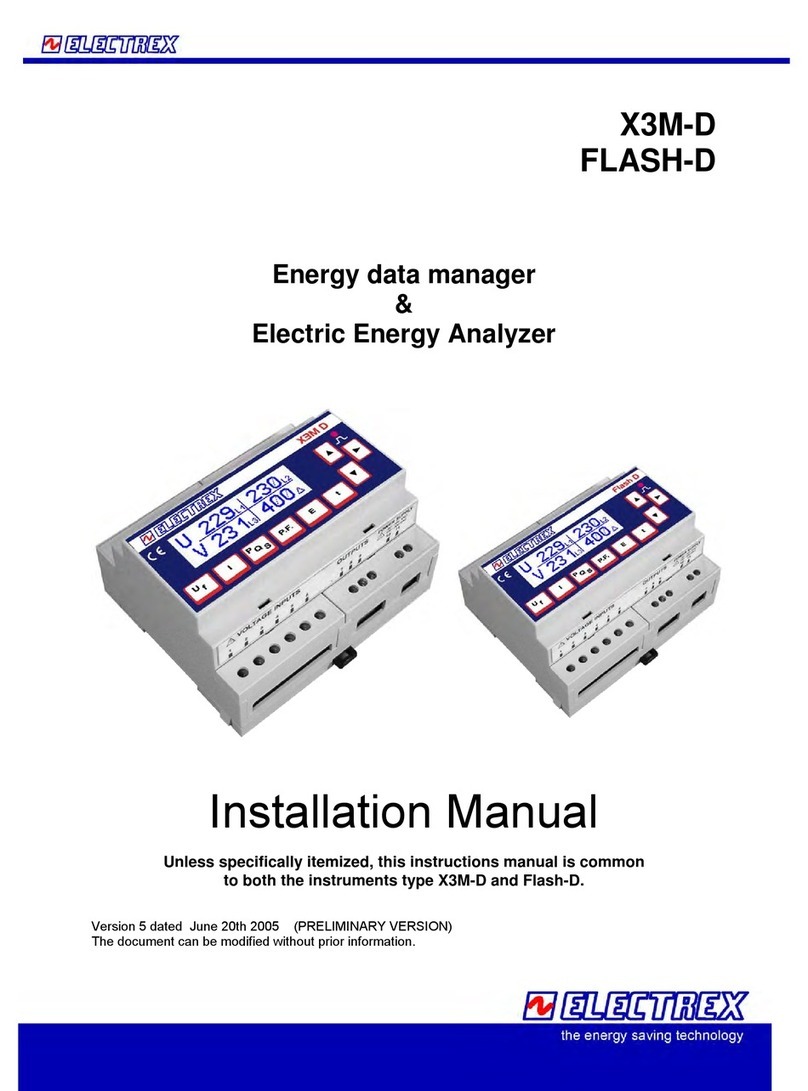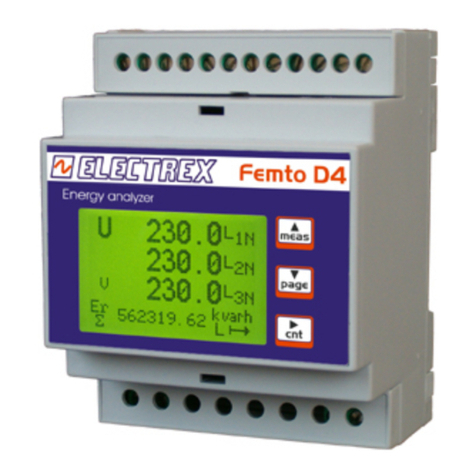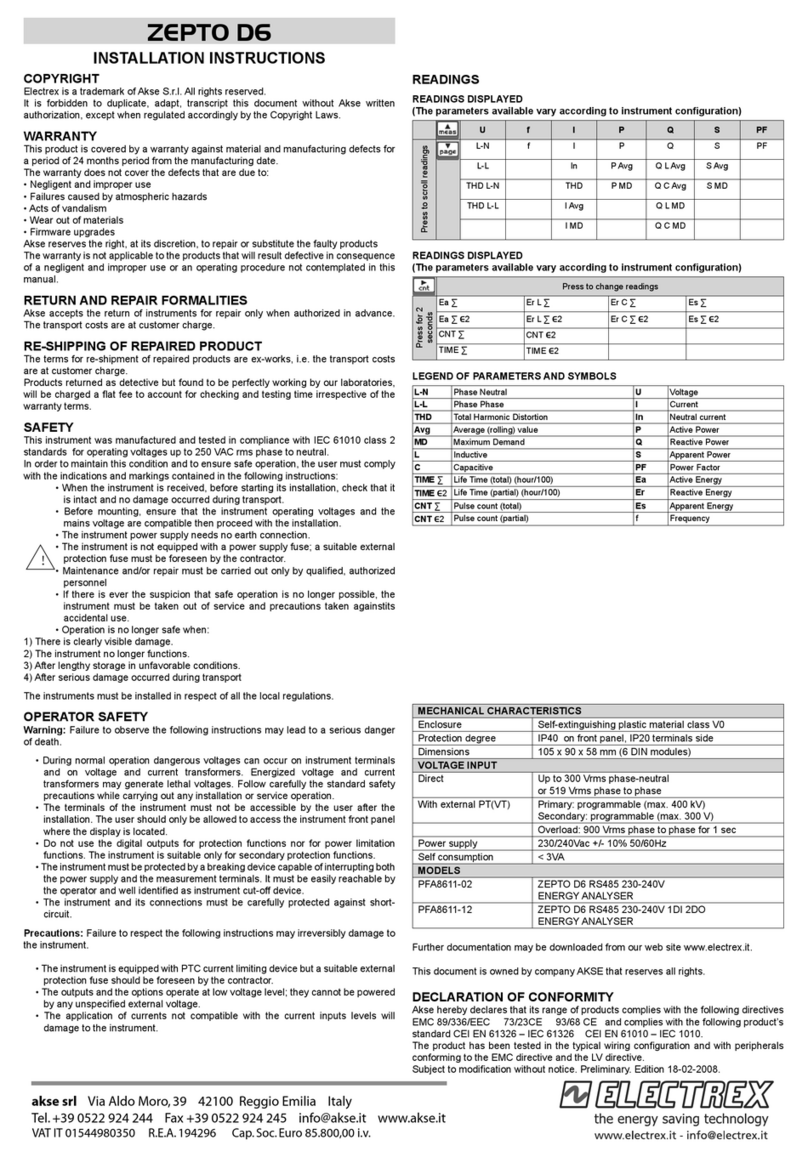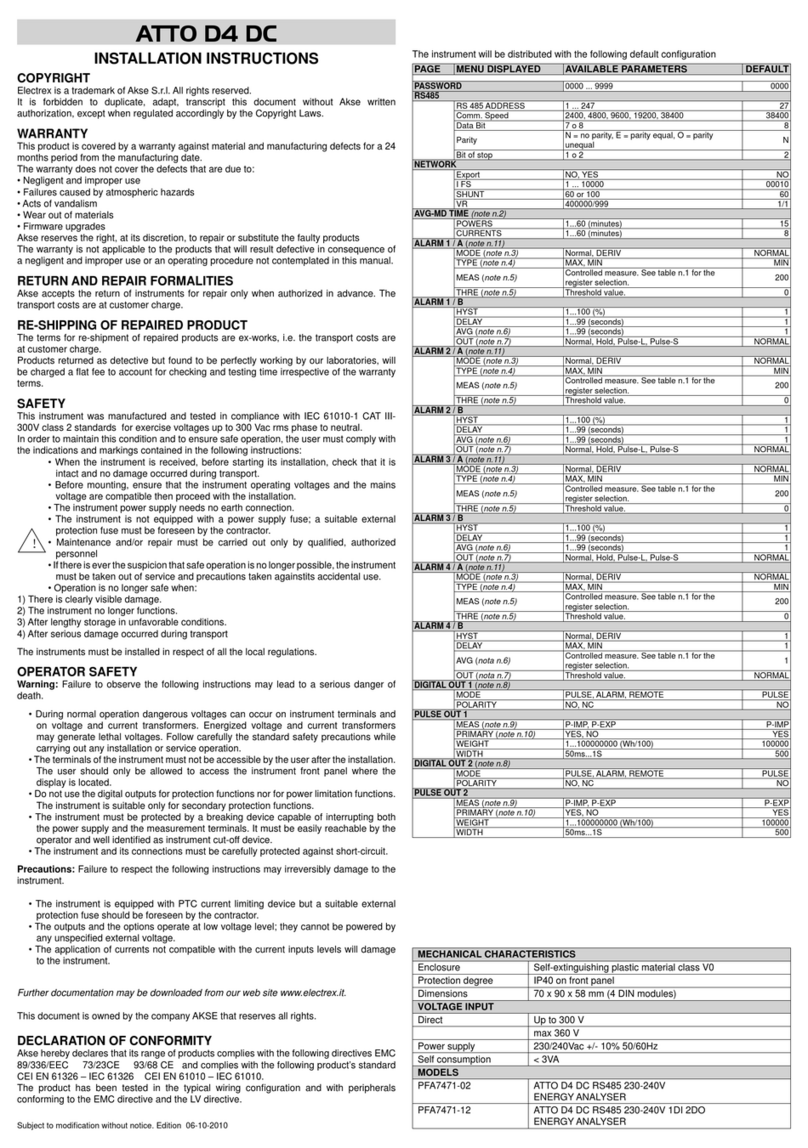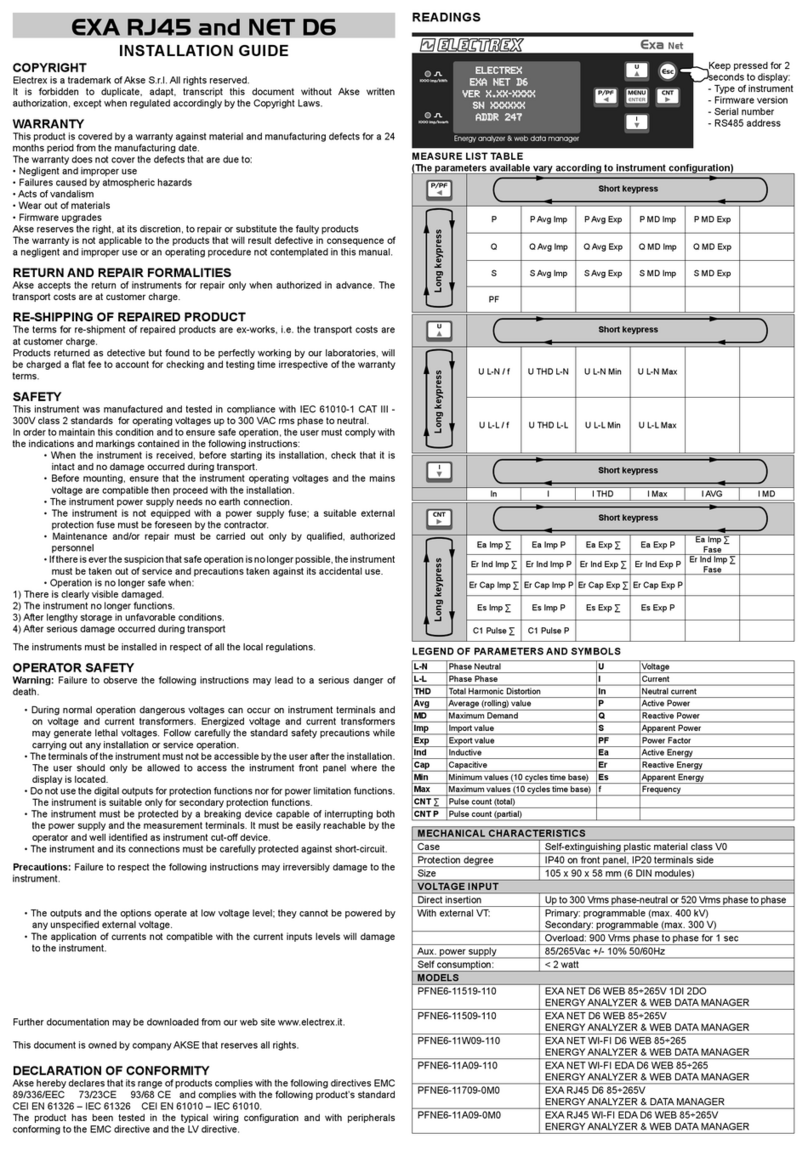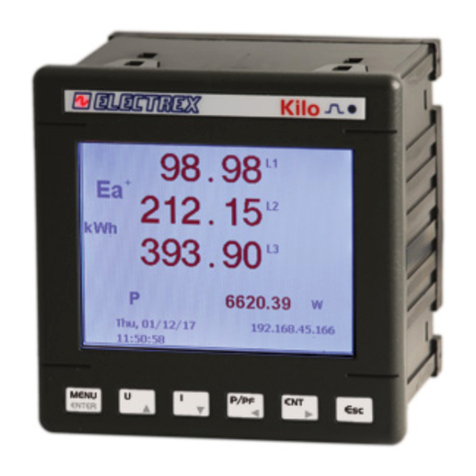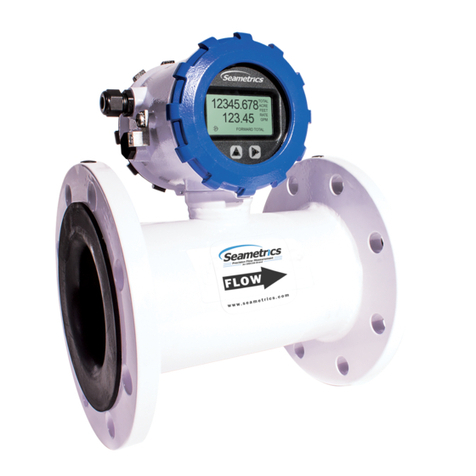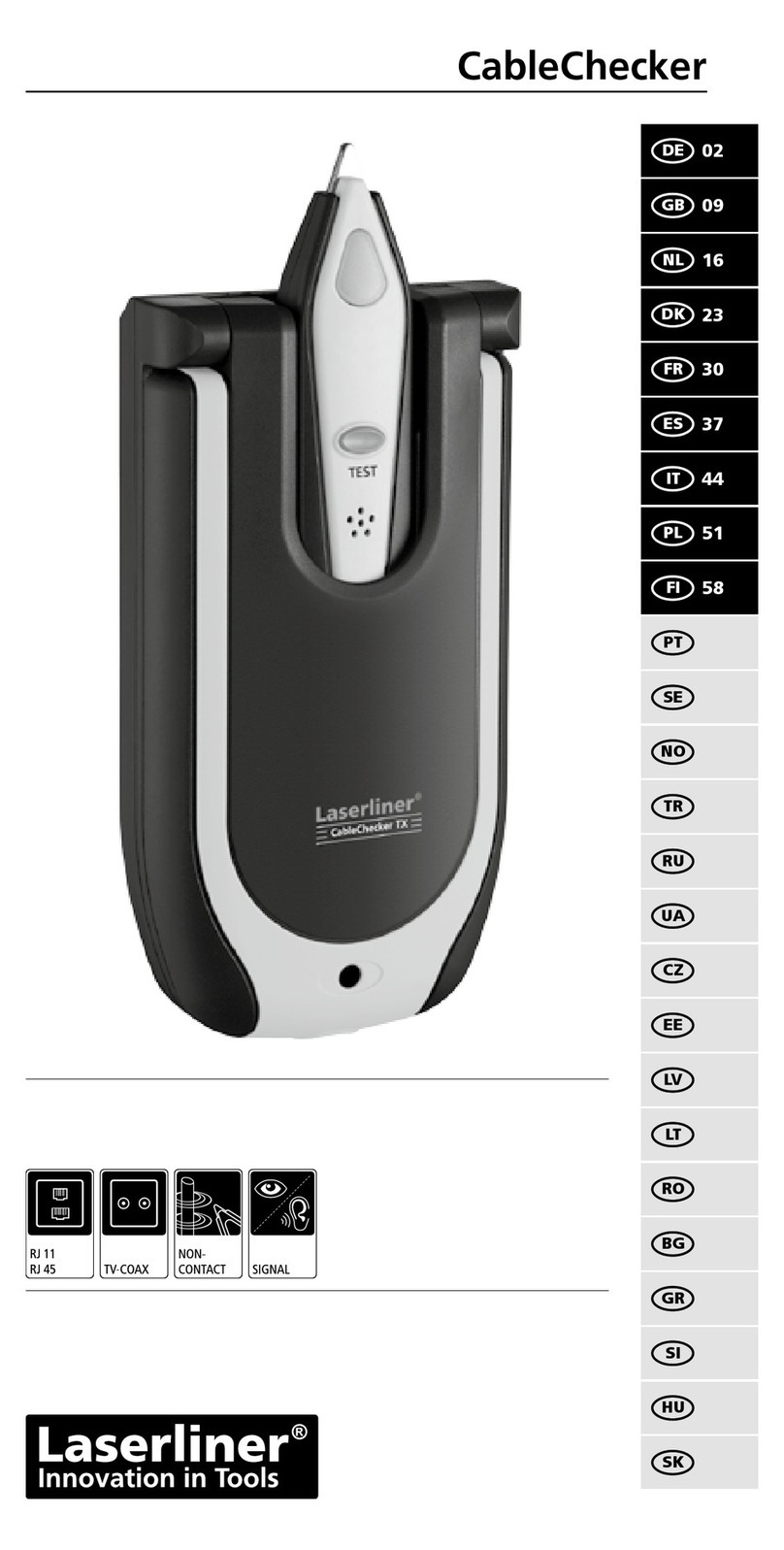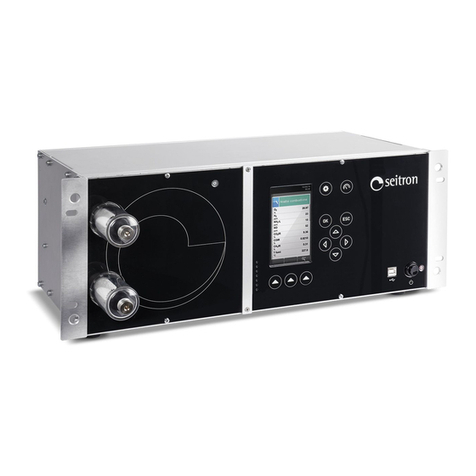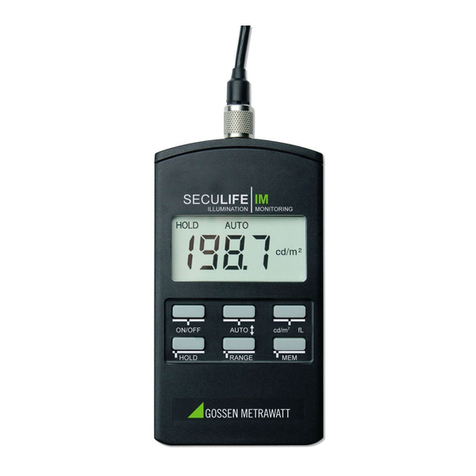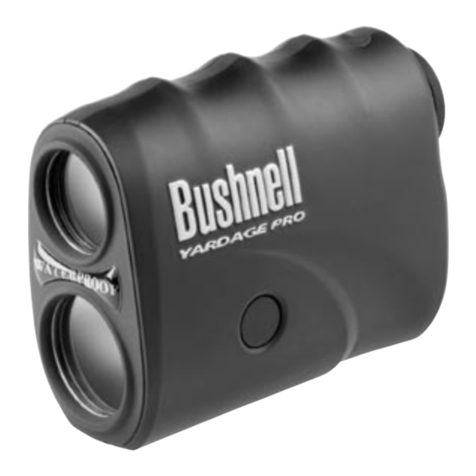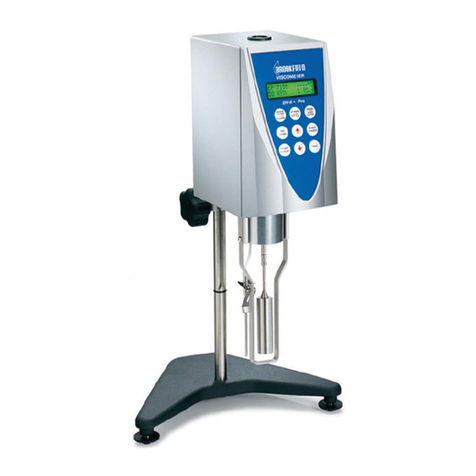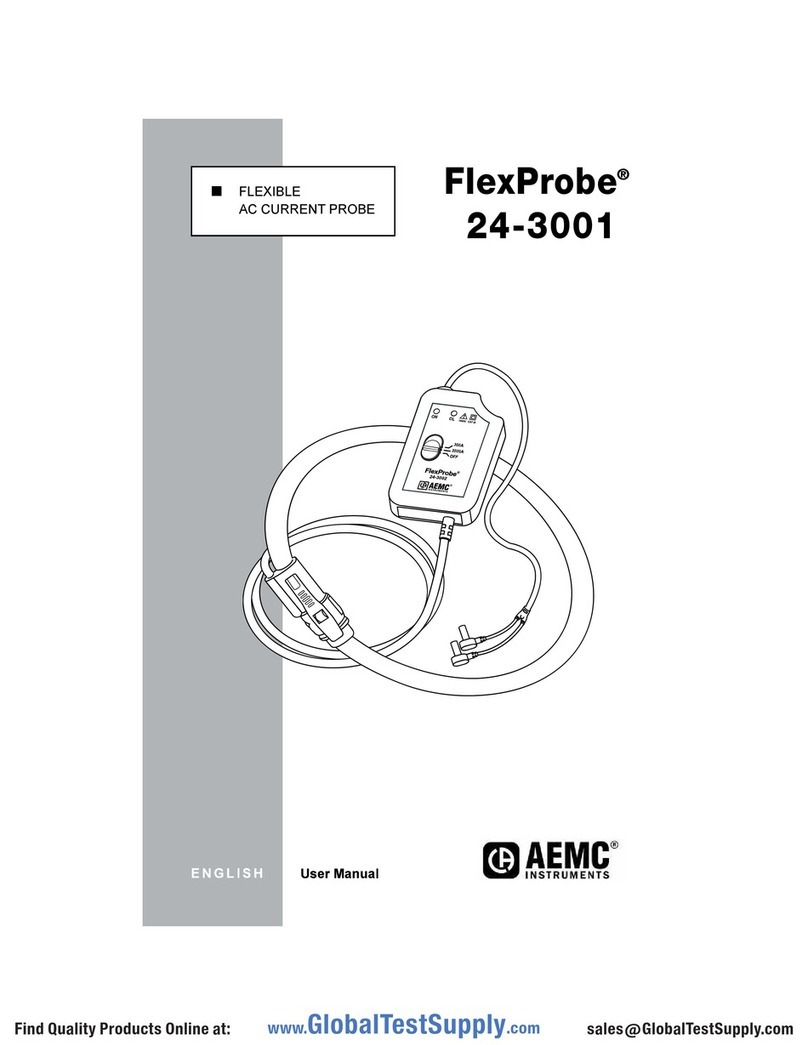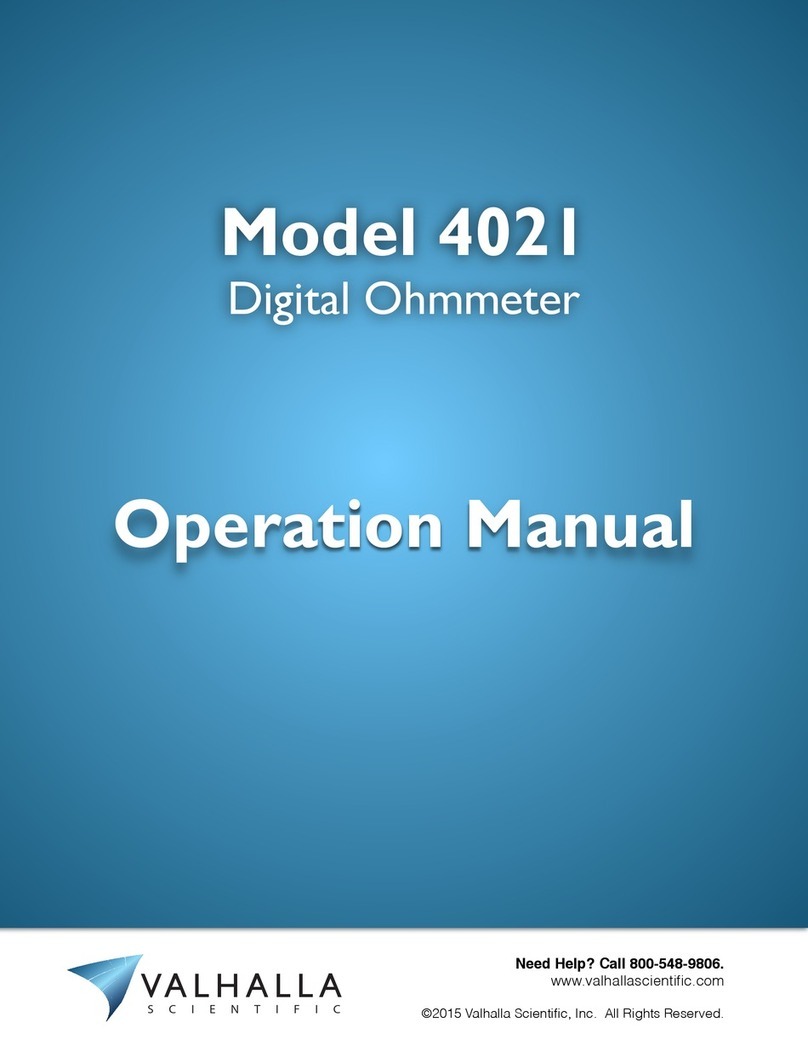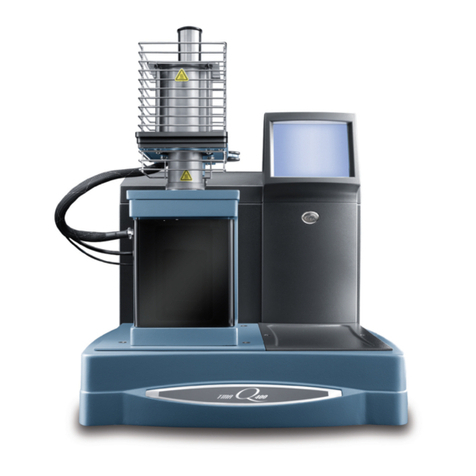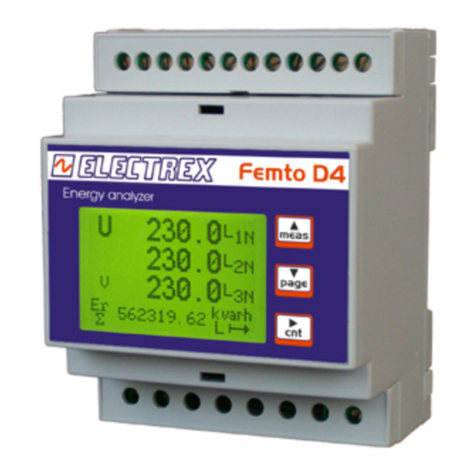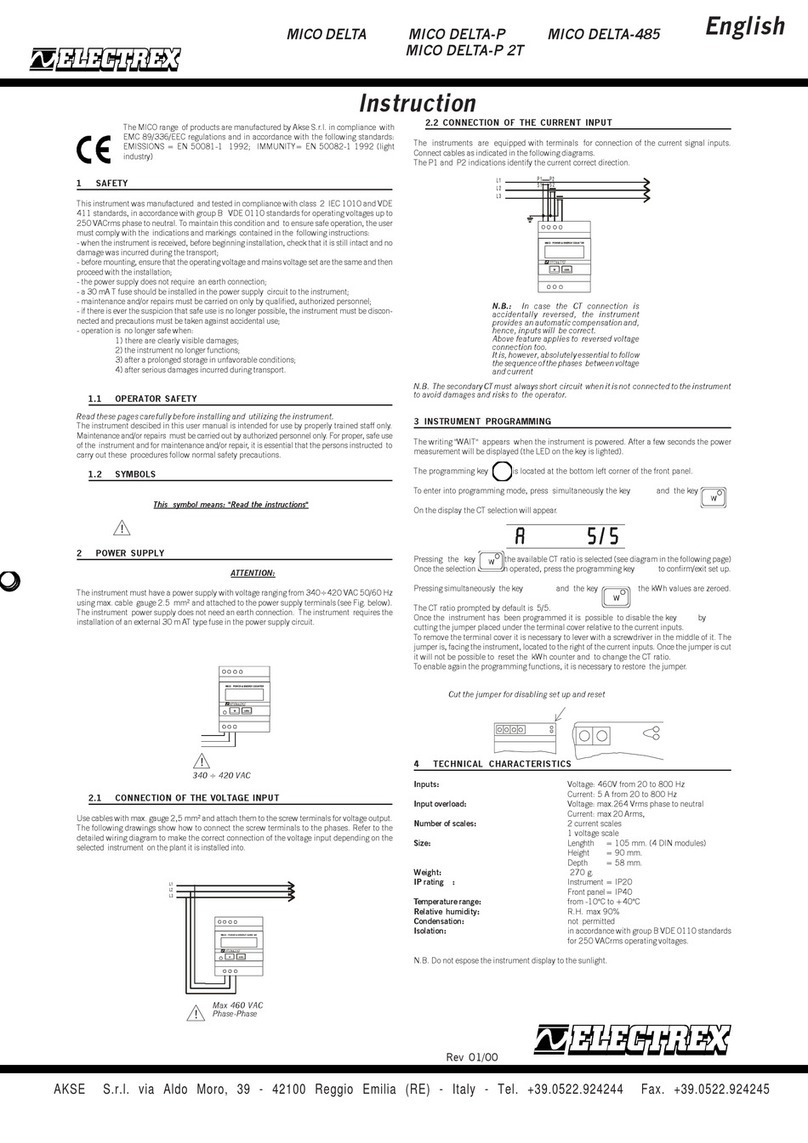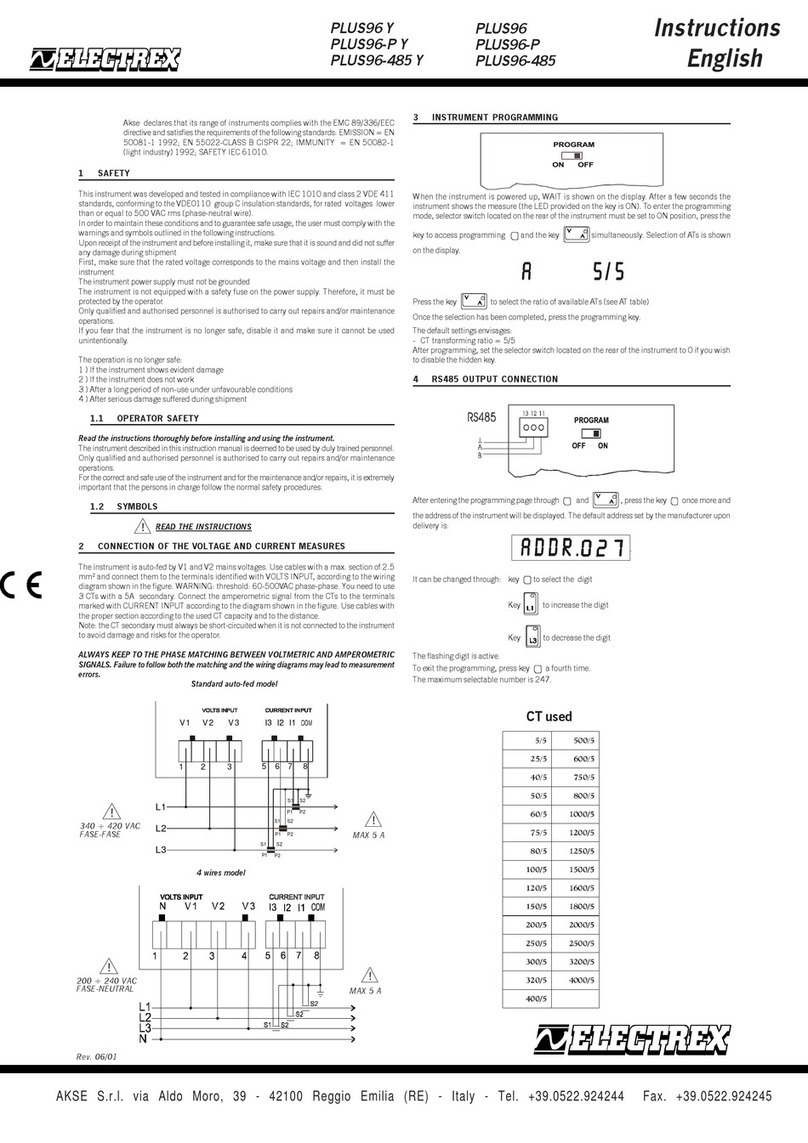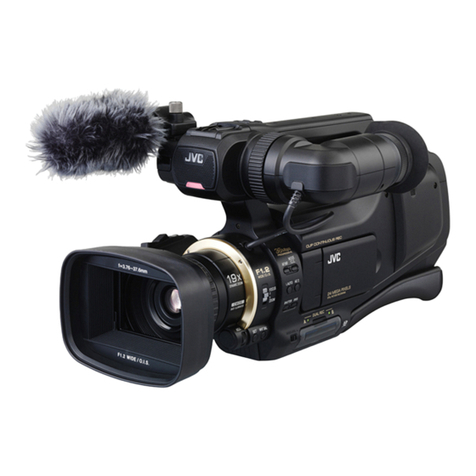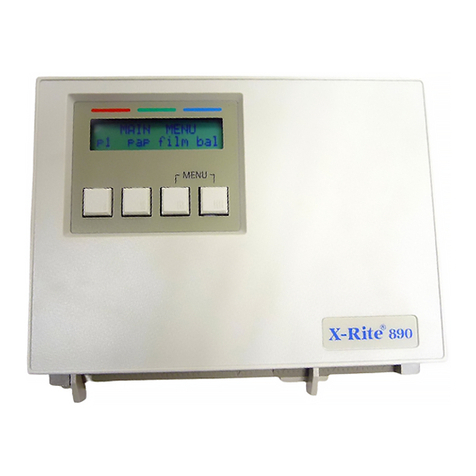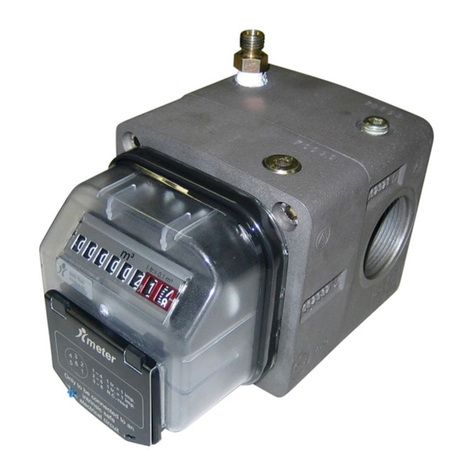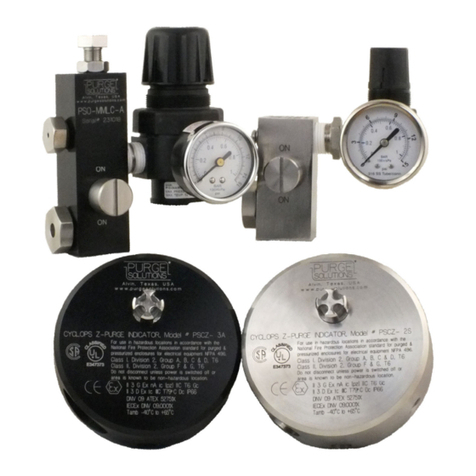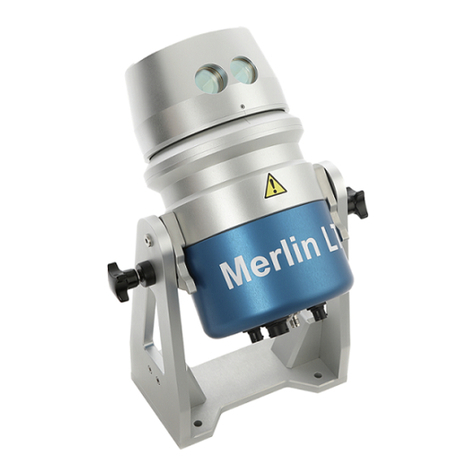
DEVICE SETUP
OPERATING KEYS
Click Change selected field
value
Change selected field value Go to next field
Click
2 sec
Go to next window Back to initial entry field Exits setup
SETUP SEQUENCE
PAGE PARAMETERS VALUES AVAILABLE DEFAULT
PASSWORD REQUEST 0000 ... 9999 0000
RS485
RS485 Address 1 ... 247 27
Rate 2400, 4800, 9600, 19200, 38400 38400
Data Bit 7 or 8 8
Parity N = no parity, E =even parity, O = odd parity N
Stop Bit 1 or 2 2
RS-485
ADDR 027
COM 38400-8-N-2
NETWORK
Type (note n.1) 3PH-3W-2CT, 3PH-4W, 2PH-2W, 1PH-2W 3PH-4W
Export NO, YES NO
CT 10000/1 or 5 5/5
VT 400000/300 1/1
NETWORK
TYPE 3PH-4W
EXPORT NO
CT 00005/5
VT 000001/001
AVG-MD TIME (note n.2)
POWERS 1...60 (minutes) 15
CURRENTS 1...60 (minutes) 8
AVG-MD TIME
POWERS 15
CURRENTS 08
ALARM 1 / A (note n.11)
MODE (note n.3) Normal, 1-OF-3, 3-OF-3, DERIV, UNBAL NORMAL
TYPE (note n.4) MAX, MIN MIN
MEAS (note n.5) Controlled measure. See table n.1 for register
selection 200
THRE (note n.5) Threshold value 0
ALARM 1/A
MODE NORMAL
TYPE MIN
MEAS 200
THRE 000.00
ALARM 1 / B
HYST 1...100 (%) 1
DELAY 1...99 (seconds) 1
AVG (note n.6) 1...99 (seconds) 1
OUT (note n.7) Normal, Hold, Pulse-L, Pulse-S NORMAL
ALARM 1/B
HYST 01
DELAY 01
AVG 01
OUT NORMAL
ALARM 2 / A (note n.11)
MODE (note n.3) Normal, 1-OF-3, 3-OF-3, DERIV, UNBAL NORMAL
TYPE (note n.4) MAX, MIN MIN
MEAS (note n.5) Controlled measure. See table n.1 for register
selection 200
THRE (note n.5) Threshold value 0
ALARM 2 / B
HYST 1...100 (%) 1
DELAY 1...99 (seconds) 1
AVG (note n.6) 1...99 (seconds) 1
OUT (note n.7) Normal, Hold, Pulse-L, Pulse-S NORMAL
ALARM 3 / A (note n.11)
MODE (note n.3) Normal, 1-OF-3, 3-OF-3, DERIV, UNBAL NORMAL
TYPE (note n.4) MAX, MIN MIN
MEAS (note n.5) Controlled measure. See table n.1 for register
selection 200
THRE (note n.5) Threshold value 0
ALARM 3 / B
HYST 1...100 (%) 1
DELAY 1...99 (seconds) 1
AVG (note n.6) 1...99 (seconds) 1
OUT (note n.7) Normal, Hold, Pulse-L, Pulse-S NORMAL
ALARM 4 / A (note n.11)
MODE (note n.3) Normal, 1-OF-3, 3-OF-3, DERIV, UNBAL NORMAL
TYPE (note n.4) MAX, MIN MIN
MEAS (note n.5) Controlled measure. See table n.1 for register
selection 200
THRE (note n.5) Threshold value 0
ALARM 4 / B
HYST 1...100 (%) 1
DELAY 1...99 (seconds) 1
AVG (note n.6) 1...99 (seconds) 1
OUT (note n.7) Normal, Hold, Pulse-L, Pulse-S NORMAL
ENTERS INTO SET UP MODE
(Push together for 2 seconds)
TABLE n.1 (ModBus Registers for alarm configuration)
REGISTER DESCRIPTION SYMBOL UNITS
200 Phase to Neutral Voltage, THD THD U1N [%]
202 Phase to Neutral Voltage, THD THD U2N [%]
204 Phase to Neutral Voltage, THD THD U3N [%]
206 Phase to Phase Voltage, THD THD U12 [%]
208 Phase to Phase Voltage, THD THD U23 [%]
210 Phase to Phase Voltage, THD THD U31 [%]
212 Phase Current, THD THD I1 [%]
214 Phase Current, THD THD I2 [%]
216 Phase Current, THD THD I3 [%]
218 Frequency of U1N f [Hz]
220 Phase to Neutral Voltage, RMS Amplitude U1N [V]
222 Phase to Neutral Voltage, RMS Amplitude U2N [V]
224 Phase to Neutral Voltage, RMS Amplitude U3N [V]
226 Phase to Phase Voltage, RMS Amplitude U12 [V]
228 Phase to Phase Voltage, RMS Amplitude U23 [V]
230 Phase to Phase Voltage, RMS Amplitude U31 [V]
232 Phase Current, RMS Amplitude I1 [A]
234 Phase Current, RMS Amplitude I2 [A]
236 Phase Current, RMS Amplitude I3 [A]
238 Neutral Current, RMS Amplitude IN [A]
240 Phase Active Power ( Imp/ Exp) P1 [W]
242 Phase Active Power ( Imp/ Exp) P2 [W]
244 Phase Active Power ( Imp/ Exp) P3 [W]
246 Phase Reactive Power ( Imp/ Exp) Q1 [var]
248 Phase Reactive Power ( Imp/ Exp) Q2 [var]
250 Phase Reactive Power ( Imp/ Exp) Q3 [var]
252 Phase Apparent Power S1 [VA]
254 Phase Apparent Power S2 [VA]
256 Phase Apparent Power S3 [VA]
258 Phase Power Factor ( Imp/ Exp) PF1 [-]
260 Phase Power Factor ( Imp/ Exp) PF2 [-]
262 Phase Power Factor ( Imp/ Exp) PF3 [-]
264 Phase to Neutral Voltage, Mean THD THD Ul [%]
266 Phase to Phase Voltage, Mean THD THD UD [%]
268 Phase Current, Mean THD THD I [%]
270 Phase to Neutral Voltage, Mean RMS Amplitude Ul [V]
272 Phase to Phase Voltage, Mean RMS Amplitude UD [V]
274 Three phase current, RMS Amplitude I [A]
276 Total active power ( Imp/ Exp) PS [W]
278 Total reactive power ( Imp/ Exp) QS [var]
280 Total apparent power SS [VA]
282 Total power factor ( Imp/ Exp) PFS [-]
332 Phase Current, RMS Amplitude, AVG I1 AVG [A]
334 Phase Current, RMS Amplitude, AVG I2 AVG [A]
336 Phase Current, RMS Amplitude, AVG I3 AVG [A]
344 Total imported active power, AVG P Imp AVG [W]
346 Total imported inductive power, AVG Qind Imp AVG [var]
348 Total imported capacitive power, AVG Qcap Imp AVG [var]
350 Total imported apparent power, AVG S Imp AVG [VA]
352 Total exported active power, AVG P Exp AVG [W]
354 Total exported inductive power, AVG Qind Exp AVG [var]
356 Total exported capacitive power, AVG Qcap Exp AVG [var]
358 Total exported apparent power, AVG S Exp AVG [VA]
376 External Pulse Counter, With Weight, Total counter
or Tariff T1
CNT1 S
384 External Pulse Counter, With Weight, Partial
Counter or Tariff T2
CNT1 P
EXIT SETUP
(push for 2 seconds)
Subject to modification without notice. Edition 02-07-2008
DIGITAL OUT 1 (note n.8)
MODE PULSE, ALARM, REMOTE PULSE
POLARITY NO, NC NO
DIGITAL OUT 1
MODE PULSE
POLATITY NO
PULSE OUT 1
MEAS (note n.9) P-IMP, QL-IMP, QC-IMP, S-IMP, P-EXP,
QL-EXP, QC-EXP, S-EXP P-IMP
PRIMARY (note n.10) YES, NO YES
WEIGHT 1...100000000 (Wh/100) 100000
WIDTH 50ms...1S 500
PULSE OUT 1
MEAS P-IMP
PRIMARY YES
WEIGHT 100.00k
WIDTH 0500
DIGITAL OUT 2 (note n.8)
MODE PULSE, ALARM, REMOTE PULSE
POLARITY NO, NC NO
PULSE OUT 2
MEAS (note n.9) P-IMP, QL-IMP, QC-IMP, S-IMP, P-EXP,
QL-EXP, QC-EXP, S-EXP QL-IMP
PRIMARY (note n.10) YES, NO YES
WEIGHT 1...100000000 (Wh/100) 100000
WIDTH 50ms...1S 500
CLEAR TOTAL COUNTERS NO, YES NO
CLEAR PARTIAL COUNTERS NO, YES NO
CLEAR MIN-MAX NO, YES NO
CLEAR MAX DEMAND NO, YES NO
ENTER NEW PASSWORD 0000 ... 9999 0000




